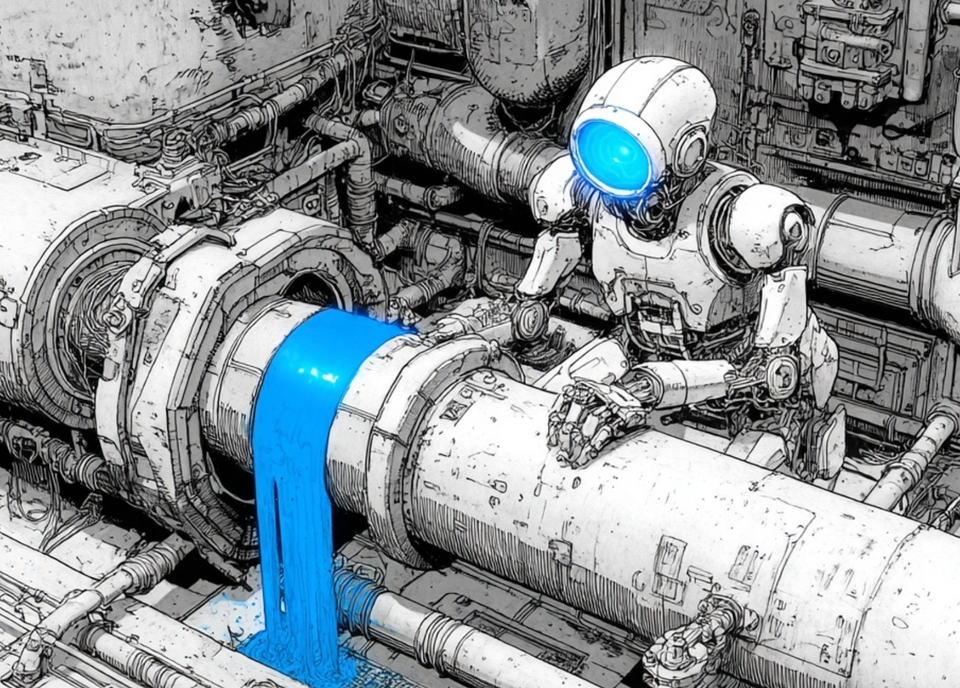What Makes a Next-Gen SIEM?
The technology for SIEM continues at a rapid pace. It's an easy statement to make, but what are the basic features that define today's Next-Gen?

Security Information and Event Management (SIEM) is constantly evolving. What “next generation” is today can be defined by four capabilities:
- Ingress piping
- User and Entity Behavior Analytics (UEBA) clustering
- AI-powered workflows
- Integrated case and response management
These are not replacing what a SIEM is. A SIEM must still handle data across diverse sources, and it must remain product-agnostic rather than tied to a single vendor ecosystem. Those qualities define a good SIEM. But what makes a next-gen SIEM is found in these four criteria.
Ingress Piping
Ingress piping is probably the most misunderstood aspect of a next-gen SIEM. In fact, many people in security have never heard the term. They know about data collection, using agents, syslog, or API calls to get logs into the SIEM, but that’s not the same thing.
Traditional data collection is static: it grabs data from a source and pushes it into the SIEM. What it doesn’t do is control the flow. Without flow control, the system risks bottlenecks, dropped records, or uneven distribution of data. In other words, it ingests, but it doesn’t manage.
Ingress piping changes this. Think of it as the traffic controller for data entering the SIEM. It absorbs information at the rate it is produced, whether that’s API feeds, syslog streams, S3 buckets, or HTTP event collectors, and ensures it is delivered where it needs to go, at the right pace, in the right format. This makes it possible to:
- Guarantee delivery: Data isn’t lost if the SIEM or downstream systems can’t immediately process it.
- Normalize and transform: Events can be enriched, cleaned up, or reshaped before they hit the core engine.
- Route flexibly: The same stream can be split to multiple destinations, whether analytics, cold storage, or compliance archives.
- Scale cleanly: Instead of dropping packets when things spike, the pipeline regulates flow and ensures continuity.
Tools like Cribl have made the concept of piping more visible in the market. They are well known, though not the first to tackle this problem, and their popularity owes as much to venture capital as to pure capability. What matters isn’t the logo on the box, it’s the architecture. A SIEM without ingress piping will eventually hit a wall. A next-gen SIEM builds this directly into its design.
Why Ingress Piping Matters
If there’s any doubt about how critical ingress piping has become, just look at the market. CrowdStrike has been branding itself as a “next-gen SIEM,” but there was a glaring hole in their architecture: no real piping capability. For a while, they tried to cover the gap through a partnership with Cribl, but it wasn’t complete and left customers without consistent flow control.
Their acquisition of Onum is their attempt to fix that. Onum itself isn’t the strongest or most advanced piping platform out there; it’s a relatively simple approach that was attractive because it was quick to buy and slot in. But the acquisition highlights the point: without ingress piping, you can’t credibly call yourself next-gen.
CrowdStrike now has a starting piece of the puzzle, but the fact they had to acquire it shows how essential this capability has become. Every SIEM vendor who wants to be in the “next-gen” category will need robust ingress piping, not just for marketing, but to handle the reality of modern data velocity and diversity.
UEBA Clustering
UEBA clustering is often talked about as if it’s one thing, but in reality it’s two related capabilities:
- Identity clustering (the “UE” part)
- Behavioral analytics (the “BA” part)
These two together create the foundation of next-gen detection.
Identity Clustering
In the early days of SIEM, everything revolved around IP addresses. That was the easiest key to group events. Later, SIEMs evolved to focus on users and entities. Today, the language has shifted again to identity. An identity can be a person, a process, a system, or even a service account. What matters is that it’s the actor.
Clustering by identity means tracking all the actions tied to that actor. Without this, logs remain a flat list of events. With it, you get a narrative: what this identity did, across systems and over time.
Behavioral Analytics
The second half of the UEBA equation, and the part where most next-gen SIEMs fail, is behavioral analytics. Behavioral analytics is about stateful analysis. It doesn’t just look at what happened; it compares it to what normally happens.
For example: “This user just logged in from an ISP they’ve never used before.” To make that statement, the system must already know the ISPs the user typically logs in from. That’s stateful awareness.
Legacy systems often fake this by brute-force database queries, searching the last 30 or 60 days of records and checking for differences. But the more properties you want to track (location, ISP, device, time of day, MFA type, etc.), the harder and more expensive that becomes. Search-based approaches collapse under the weight of complexity.
True behavioral analytics operates in flow, keeping state continuously updated so it can scale across many properties without performance collapse. That’s the missing piece in most SIEMs marketed as “UEBA.” They cluster using database keys, and then stop. No stateful behavior. No real BA.
Identity + Behavior = Next-Gen
When you combine identity clustering with behavioral analytics, you get what’s essentially Identity Behavioral Analytics (IBA). And that’s the real cornerstone of next-gen detection. Without it, SIEMs reduce to simple keying and static searches. With it, they begin to approach the depth required for true case-level analysis, the bridge into case and response management that we’ll explore later.
AI Workflows
When most vendors talk about “AI in SIEM,” they usually mean a copilot. Something that helps an analyst write a query, summarize results, or explain what a log means. That is not a workflow. It is a tool bolted onto an old process.
True AI workflows are different. They do not assist the analyst; they replace the analyst. That can sound harsh, but it does not mean people disappear from the picture. Instead of doing entry-level triage, people move into quality assurance roles where they review results, provide oversight, and improve workflows.
This matters because entry-level triage has always been limited by skill gaps. Large Language Models, when paired with structured workflows, already outperform junior analysts at validation, scoping, and recommending next steps. The important shift is that the process remains, but the person running it changes. The workflow stays intact; it is simply executed by AI.
The more specific the workflow, the better the results. A workflow built for “impossible travel” or “account impersonation” consistently produces higher-quality answers than a generic query. Smaller, targeted prompts yield better outcomes. In practice, investigations often involve several workflows running in parallel, each producing results that feed back into the SIEM.
This leads to two key takeaways:
- AI workflows replace the person, not the process.
- AI workflows increase both quality and scalability.
With structured AI workflows in place, alert fatigue fades away. Processing power can be applied without limit, and workflows ensure that every event is handled with the same rigor at 2 AM as at 2 PM. Standardization and repeatability raise quality across the board, often more effectively than training programs or process checklists.
AI workflows are not a bolt-on. They are not a chatbot. They are the next layer of the SIEM itself. Combined with ingress piping and identity-behavioral clustering, they transform detection from a manual task into a continuous, scalable, and high-quality system.
Case and Response Management
One of the longest-running challenges for SIEMs has been case management. In the early 2000s, the default approach was to generate a case for every single alert. That might have worked at very small scale, but with today’s volumes it is unworkable. Modern case management requires a different approach.
Cases should be built around identities or clusters of related identities, not individual alerts. This provides two key advantages:
- Reduction of volume. Grouping alerts into cases dramatically reduces the number of tickets generated. For example, if cases are keyed to an identity such as an email address, then the maximum number of cases is bounded by the number of identities, not the number of events. UEBA clustering naturally feeds into this reduction by consolidating activity around people, systems, or processes.
- Lifecycle tracking. Cases allow the SOC to track closure, reoccurrence, and state transitions across related events. Rather than closing alerts one by one, cases enable the team to manage sets of activity together. This provides better visibility, stronger metrics, and cleaner workload management.
The advantage goes even further when identity normalization is done correctly. If a user’s email address can be tied consistently across different sources, such as Office 365 and endpoint protection logs, then alerts from both systems can be clustered into the same case. This identity-level consistency makes case management vendor-agnostic and allows for true consolidation across the environment.
It is important to note that case management is not the same as investigation. Investigations are about deep technical analysis. Case management, by contrast, is about closure. It ensures that alerts are consolidated, tracked to completion, and monitored for reoccurrence. Many tools confuse case management with investigation.
Conclusion
Next-gen SIEM isn’t about buzzwords. It’s about building a system that keeps up with the speed of change. Ingress piping, UEBA clustering, AI workflows, and case and response management define the line between a good SIEM and a true next-generation SIEM.
Next-gen SIEM isn’t about buzzwords. It is about building a system that keeps pace with technology. Ingress piping, UEBA clustering, AI workflows, and case and response management mark the line between a traditional SIEM and a next-generation SIEM. All of these are in Fluency SIEM today.
Even after 25 years in the market, SIEM technology is still evolving. The drivers are twofold: advances in data analytics and analysis and the advances in infrastructure. Early SIEMs were focused largely on networks. Today’s environments span cloud, identity, applications, and endpoints. That broader scope demands new approaches. They also have greater volumes of logs to process.
We still need the core capabilities of a traditional SIEM, but modern architectures require far more. Next-gen SIEMs build on that foundation with a new set of capabilities designed for scale, complexity, and speed. When evaluating a SIEM, it is not enough to look for basic log collection and alerting. The features that define the next generation are clear, and they will determine whether the platform can keep up with today’s challenges.




